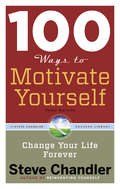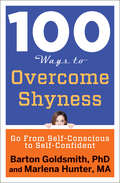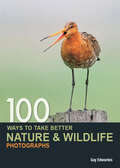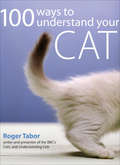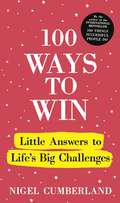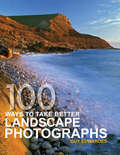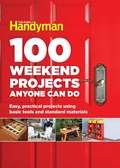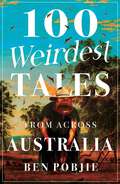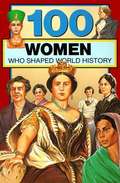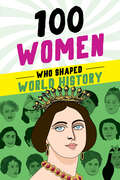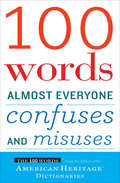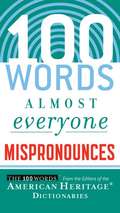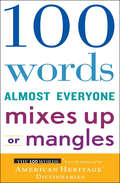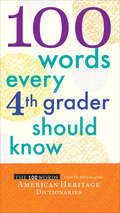- Table View
- List View
100 Ways to Motivate Others: How Great Leaders Can Produce Insane Results Without Driving People Crazy (100 Ways)
by Scott Richardson Steve ChandlerThe business leadership coaching classic, revised and updated for today’s workplace.The world of leadership has changed dramatically since 100 Ways to Motivate Others was written, and now Chandler and Richardson have revised and refreshed their organizational classic to meet the times.They have crafted a vital, user-friendly, inspirational guide for executives, managers, and professionals . . . and those aspiring to reach their level. 100 Ways to Motivate Others is based on years of successful live workshops, seminars, and personal coaching programs on communication and leadership.This new edition includes fresh insights into communication and rapid decision-making, the importance of personal self-leadership and physical energy, and exciting new methods for enrolling clients and selling to customers in service-oriented ways that leave behind the old paradigm of manipulation and persuasion. The authors will help you learn:How to slow down and enjoy a new level of focus.How to build on your peoples’ strengths.A simple and creative way to hold people accountable.How to enjoy cultivating the art of supportive confrontation.“Steve Chandler’s coaching has had a tremendous impact in my life. He was vital to my personal transformation from a man of ideas and dreams to a person of action and reality.” —Radames Soto, former managing director, The Wall Street Journal“Steve Chandler lights you up with the glow of his internal neon . . . what he proposes is so rock solid and reassuring.” —Lisa Schnebly, The Arizona Republic
100 Ways to Motivate Yourself, Third Edition: Change Your Life Forever (100 Ways Series)
by Steve ChandlerWith the third refreshed edition of 100 Ways to Motivate Yourself, Steve Chandler helps you create an action plan for living your vision, in business and in life. It features 100 proven methods to positively change the way you think and act—methods based on feedback from the hundreds of thousands of corporate and public seminar attendees Chandler speaks to each year. The book now also includes techniques and breakthroughs he has created for individual coaching clients.100 Ways to Motivate Yourself will help you break through the negative barriers and banish the pessimistic thoughts that are preventing you from fulfilling your lifelong goals and dreams. This edition also contains new mental and spiritual techniques that give readers more immediate access to action and results in their lives.If you’re ready to finally make a change and reach your goals, Steve Chandler challenges you to turn your defeatist attitude into energetic, optimistic, enthusiastic accomplishments.
100 Ways to Overcome Shyness
by Marlena Hunter Barton Goldsmith100 Ways to Overcome Shyness is a powerful collection of useful information, case studies, and exercises on how to manage your shyness so you can communicate with people you don't know very well (or at all) in a wide range of personal and professional settings and circumstances. Easy-to-use conversation starters are interspersed with lists and exercises throughout the book. There are also chapters on getting out of awkward conversations graciously, plus valuable tips and insights on how to deal with shyness for those with social anxiety or those who are on the Autism spectrum. Each chapter also contains talking points to give you springboards for discussion. 100 Ways to Overcome Shyness will show you how to: Feel more comfortable at parties, meetings, and group gatheringsNavigate your way through awkward situationsDeal positively with the fear of rejectionCommunicate more effectively at work and in your daily lifeHandle arguments and other emotional situationsDeal effectively with difficult people If you feel your shyness has held you back and prevented you from living fully, 100 Ways to Overcome Shyness will give you the tools you need to change your life, once and for all.
100 Ways to Simplify Your Life
by Joyce MeyerJoyce Meyer is one busy lady. Apart from the normal demands of life, she teaches daily on TV and radio, writes books, holds conferences in dozens of cities every year and ministers around the world...and she runs Joyce Meyer Ministries. So she's had to learn how to make the most of every minute of the day! In 100 Ways to Simplify Your Life, Joyce shares the most effective secrets she's learned over the years for making the most of each minute of the day. In less than two pages per entry, Joyce gives us eminently 'doable' tips that are clearcut and ...well, SIMPLE. But they can change your whole outlook, not to mention your schedule.
100 Ways to Simplify Your Life
by Joyce MeyerMany want a simple life, but find it difficult to actually live that way. They fight a constant battle to balance work, family, friends, and other demands on schedules stretched too thin. Joyce Meyer breaks it down to the simple principle of exercising faith rather than doubt and confidence rather than people-pleasing. She writes from her experience of struggling to balance work, family, friends, and all the other demands on limited time to show readers the simple answer to a simpler life.Joyce gives these and other practical and easy to implement ideas for finding real joy:· Live to glorify God · Let go of what lies behind · Choose your battles · Don't be afraid of what people think · Trust God to change other people · Live with margin · Don't be so hard on yourself · Stop doing things you don't do well · Remember that God is for you.Joyce reminds readers that the Bible is full of examples of God's provision and His instruction to focus on one day at a time. She encourages readers to set themselves free by realizing they don't have to do, fix, or manage everything. By embracing the fact that God is on their side they will be encouraged that he will help find a way to live a simple life.
100 Ways to Stay Calm: Simple Tips and Tricks to Relax Your Mind and Body
by Adams MediaBecoming more relaxed is easier than you thinkHere at your fingertips are dozens of different ideas on how to unwind and reduce stress. With 100 Ways to Stay Calm as your guide, things are going to get a little more peaceful, a little more relaxing, and a whole lot less hectic. From setting lavender out in your home to practicing mantra meditation, these hundred simple tips will help you take the stress out of your day.
100 Ways to Take Better Nature & Wildlife Photographs
by Guy EdwardesThis guide is suitable for all levels of photographers. 100 Ways to Take Better Nature and Wildlife Photographs features 100 practical and inspiring tips on every aspect of the genre. Guy Edwardes' breath-taking pictures accompany his eas-to-follow advice on a wide range of subjects from capturing the actions of large mammals to snapping wild birds and flowers in the garden.With tips on everything from technique to composition, coping with extreme field conditions to Photoshop software manipulation, this is an invaluable guide for anyone with a passion for photography of the natural world.
100 Ways to Take Better Portrait Photographs
by Daniel Lezano Bjorn Thomassen100 Ways to Take Better Portrait Photographs is a practical and informative guide to every aspect of portrait photography from informal pictures of family and friends to professional studio techniques. It contains:Straightforward, practical tips and adviceOver 100 inspirational portrait photographsInvaluable digital manipulation techniquesWhether you're earning a living as a professional portraitist or snapping informal social shots just for fun, this latest reference volume offers clearly presented advice on the many aspects of digital and film portraiture:Composition and posingOutdoor and studio portraitsFashion, glamour and beauty shotsGroup portraits - family, social, corporate and business
100 Ways to Train the Perfect Dog
by Sarah Fisher Marie MillerDiscover 100 ways to train a well-mannered, calm, confident and happy family pet by following the expert advice from experienced dog trainers Sarah Fisher and Marie Miller. Practical step-by-step instruction and clear photographs demonstrate essential techniques, including TTouch bodywork and clicker training. Progressive exercises and bronze, silver and gold certificates provide structure and achievable goals, enabling you to teach your dog key skills. Fun games reinforce the training, giving your dog appropriate mental and physical stimulation. Whether you are training a puppy or solving specific problems with an older dog, this positive guide is the perfect companion and will help to deepen the understanding and trust between you and your dog.
100 Ways to Understand your Cat
by Roger TaborEverything you need to understand about your cat is here in this essential owner's handbook. Discover 100 fascinating aspects of your cat's habits and lifestyle, learn how your cat communicates with both you and their feline friends, and become confident in caring for your cat, for a happy and rewarding relationship. This eBook features six major subject areas; how cat's work, a cat's life, cat families, cat behaviour, keeping cats, and cat troubles, as well as straight-forward cross-referencing to related subjects, as well as fascinating in-depth features that also give insight into the mysterious world of the cat.
100 Ways to Win: Little Answers to Life’s Big Challenges
by Nigel CumberlandYour Guide to GreatnessThis is your toolkit for turbo-charging every aspect of your life, from your boldest ambitions to your daily routines.100 Ways to Win is packed with great ideas for achieving professional highs, building rewarding relationships, and finding peace, all carefully chosen to help you navigate whatever challenges and opportunities cross your path.Every chapter features a new idea to help you form the habits and mindset of a winner. Together, they are your springboard to success.100 Ways to Win is your guide to the life you want, one small win at a time.Praise for 100 THINGS SUCCESSFUL PEOPLE DO'Inside these pages you'll find a powerful reminder of the many ways you can make your life - and other people's lives - more successful. It will help you identify what success means to you and give you the building blocks for making that success a reality. This is your chance to overcome whatever obstacles are stopping you. Read it, act on it and experience the difference' Marshall Goldsmith Ph.D., bestselling author of TRIGGERS
100 Ways to Win: Little Answers to Life’s Big Challenges
by Nigel CumberlandYour Guide to GreatnessThis is your toolkit for turbo-charging every aspect of your life, from your boldest ambitions to your daily routines.100 Ways to Win is packed with great ideas for achieving professional highs, building rewarding relationships, and finding peace, all carefully chosen to help you navigate whatever challenges and opportunities cross your path.Every chapter features a new idea to help you form the habits and mindset of a winner. Together, they are your springboard to success.100 Ways to Win is your guide to the life you want, one small win at a time.Praise for 100 THINGS SUCCESSFUL PEOPLE DO'Inside these pages you'll find a powerful reminder of the many ways you can make your life - and other people's lives - more successful. It will help you identify what success means to you and give you the building blocks for making that success a reality. This is your chance to overcome whatever obstacles are stopping you. Read it, act on it and experience the difference' Marshall Goldsmith Ph.D., bestselling author of TRIGGERS
100 Ways to take better Landscape Photographs
by Guy Edwardes100 Ways to Improve Your Landscape Photographs is an easy-reference guide to landscape photography; packed with practical advice and stunning photos this book will help and inspire photographers of all levels. This is a simple and comprehensive trouble-shooting guide to landscape photography. The book is divided into themed sections and features simple explanations of techniques, which will help both beginners and more advanced photographers get the results they want. The thematic sections cover all areas of landscape photography, including coastal, panoramic and seasonal, as well as lighting effects, composition and exposure.
100 Weekend Projects Anyone Can Do: Easy, practical projects using basic tools and standard materials
by Editors at The Family Handymanuild fashionable, functional, inexpensive indoor and backyard furniture--even if you're a complete beginner. These are realistic projects for the average weekend warrior that require no great skills, just normal tools you already have and easy-to-buy materials available at any home store. Here's a small sample of what's inside: Build a simple-but-stylish bookcase Cut garage clutter with oversized shelves Double your closet space with easy accessories Build a rock-solid workbench in 3 hours Maximize kitchen storage with clever cabinet inserts Build backyard furniture, a garden arbor, planters and more! Benches, garden and deck chairs Outdoor storage Quick projects like bird houses, handy hints, and more
100 Weight Loss Bowls: Build your own calorie-controlled diet plan
by Heather WhinneyYou can lose weight—one bowl at a time. Putting all the food for a meal into one bowl might sound like an odd way to lose weight. But this method creates portion control while also contributing to a balanced diet. Every recipe in this book has a label to denote whether it&’s under 300, 400, or 600 calories. Many recipes also have flags to signify whether they&’re dairy free, gluten free, or vegan, helping you ensure you&’re not going to eat anything that might cause concern. 100 Weight Loss Bowls includes these features: • 100 delicious recipes for breakfast, brunch, portable meals, quick meals, and comfort food • Different kinds of bowls, including pho, grain, smoothie, rice, poke, acai, and Buddha • Expert advice on how to build meal plans to help you meet your weight loss goals Because 100 Weight Loss Bowls contains a variety of recipes—such as fruit and oatmeal, fish and rice, and noodles and vegetables as well as recipes inspired by international cuisine—you might never need to eat from a plate again!
100 Weirdest Tales from Across Australia
by Ben PobjieTales of the strange, unnerving and downright bizarre from one of the weirdest places on EarthFish falling out of the sky, joggers relieving themselves on your doorstep, mysterious monsters constantly springing from the shadows, spooky lights and ill-conceived toast spreads: these are just some of the things you can expect on any given day in our surreal southern land.In 100 Weirdest Tales from Across Australia, comedy writer and accredited weirdness expert Ben Pobjie delves deep into Australia's past and present to serve up the weirdest stories of all, which will leave you smacking your gob with one hand while scratching your head with the other.
100 Weirdest Tales from Across Australia
by Ben PobjieTales of the strange, unnerving and downright bizarre from one of the weirdest places on EarthFish falling out of the sky, joggers relieving themselves on your doorstep, mysterious monsters constantly springing from the shadows, spooky lights and ill-conceived toast spreads: these are just some of the things you can expect on any given day in our surreal southern land.In 100 Weirdest Tales from Across Australia, comedy writer and accredited weirdness expert Ben Pobjie delves deep into Australia's past and present to serve up the weirdest stories of all, which will leave you smacking your gob with one hand while scratching your head with the other.
100 Whimsical Applique Designs: Mix & Match Blocks to Create Playful Quilts from Piece O' Cake Designs
by Becky Goldsmith Linda JenkinsDiscover how to create playful quilts with this collection of 100 Piece O&’ Cake appliqué designs. Stitch your way through 100 whimsical appliqué designs from Piece O&’ Cake Designs to make fun and charming quilts, table runners, and other sewing projects for the home. This collection captures the whimsy and imagination fans of Piece O&’ Cake designs have come to love. Mix and match playful houses, flower bouquets, charming animals, and more cozy motifs! Use your favorite quilting methods to make these appliqué blocks in wool, cotton, or a mix of both — the patterns are versatile for endless play! With Becky Goldsmith and Linda Jenkins' combined mastery of the craft, you'll find helpful tips and tricks. · Mix and match 100 whimsical appliqué designs to make quilts, table runners, and other sewing projects · Piece O&’ Cake designers Becky Goldsmith and Linda Jenkins show you how to easily use the appliqué patterns and provide a sizing table so you can create blocks in the size of your choice · Explore border sewing options and pattern grouping suggestions for endless project possibilities
100 Women Who Shaped World History
by Gail Meyer RolkaA comprehensive collection of one page synopses of 100 women of major importance in our history. Presents information in chronological order, contains timeline, and a trivia quiz. The book begins in 1503 BC and ends by telling the stories of women who are still making history.
100 Women Who Shaped World History (100 Series)
by Gail Meyer RolkaLearn all about the fascinating lives and tremendous impact of 100 extraordinary women around the world with this fact-filled biography collection for kids. Educational and engaging, 100 Women Who Shaped World History features:Simple, easy-to-read text that has been freshly updatedIllustrated portraits of each figureFascinating facts about famous and lesser-known female figures from historyA timeline, trivia questions, project ideas and more!From Cleopatra to Joan of Arc, Ada Lovelace to Harriet Tubman, Amelia Earhart to Rosa Parks and many more, readers will dive into the lives of 100 female artists, activists, scientists, and icons who left their mark on history. Organized chronologically, this thoroughly researched biography collection offers a look at the contributions these women made and how their talents, discoveries, and ideas have helped guide humanity for thousands of years.
100 Women: Architects in Practice
by Harriet Harriss Naomi House Tom Ravenscroft Monika ParrinderAll the architects in this book deserve international recognition. The reality is, though, that few are household names. Over the last decade, awareness of the need for gender balance in architecture has gained traction. Within the profession, women remain underrepresented, underpromoted and underpaid. Failure to acknowledge women’s contribution to the built environment has perpetuated this cycle and impoverished us all. By showcasing 100 exceptional architects – who happen to be women – this book provides a flagship reference to inspire and support everyone working in the profession, no matter how they identify. Global in outlook, the book presents an equitable sample of architects from every continent. We all need heroines as much as heroes. Through illustrated interviews, each woman shares how they are responding to a profound disconnect between architecture and the people and landscape it serves. Their visions, methods and models of leadership are essential to connecting the needs of humans and the planet. In the words of Indigenous Canadian architect Eladia Smoke: ‘Now is a critical time to seek out every opportunity to transmit this knowledge to future generations.’ Featuring: 100 interviews with leading women architects, including: Tatiana Bilbao, Odile Decq, Liz Diller, Julia Gamolina, Dorte Mandrup and Farshid Moussavi. Over 400 photographs and drawings. Geographically balanced selection, with profiles across every continent.
100 Words Almost Everyone Confuses and Misuses (100 Words)
by Editors of the American Heritage DictionariesAvoid vocabulary mistakes with this fun guide to tricky and troublesome words! With concise and authoritative usage notes from the editors of the American Heritage® Dictionaries, this guide explains common English-language errors—whether it&’s mixing up affect and effect; blatant and flagrant; or disinterested and uninterested, or stumbling over sound-alikes including discrete/discreet or principal/principle. Other notes tackle such classic irritants as hopefully, impact, and aggravate, as well as problematic words like peruse and presently. A great read for anyone who cares about getting it right, 100 Words Almost Everyone Confuses and Misuses can help keep writers and speakers on the up-and-up!
100 Words Almost Everyone Mispronounces
by American Heritage Dictionary EditorsThis latest installment in the bestselling 100 Word series settles the score on 100 controversies and misconceptions about words with difficult or slippery pronunciations.
100 Words Almost Everyone Mixes Up or Mangles (100 Words)
by Editors of the American Heritage DictionariesEliminate mistakes and improve your vocabulary with this engaging guide to the world&’s most misused words. Do you know your delegate from your relegate, your cachet from your cache? At one time or another we&’ve all suffered the embarrassment of having our remarks corrected by a family member, colleague, or stranger. 100 Words Almost Everyone Mixes Up or Mangles presents fifty pairs of words that people have trouble getting right and keeping straight—words that tend to get corrected when we&’re least expecting it. These words include near-synonyms—words with subtle but important distinctions in meaning—like baleful vs. baneful, and effectual vs. efficacious. Other pairings bring together notorious sound-alikes, like faze (bother) vs. phase (stage), pour (put in fluid) vs. pore (read closely), and waive (forgo) vs. wave (say hello). The book also addresses some classic spelling blunders and &“nonwords,&” like beyond the pail, full reign, injust, and inobstrusive. Each word has a definition and a pronunciation, and most have etymologies explaining the word&’s origin. The mix-ups themselves are described in fun-to-read notes that provide clear solutions to help readers avoid making needless, uncomfortable gaffes. 100 Words Almost Everyone Mixes Up or Mangles gives readers the chance to improve their command of words that are often heard but just as often misused.
100 Words Every 4th Grader Should Know (100 Words)
by Editors of the American Heritage DictionariesThis A-to-Z reference is a fun way for elementary-school kids to improve their vocabulary—and become better readers and writers. With 100 Words Every 4th Grader Should Know, parents and teachers can present new and challenging words that will prepare kids to excel in their classes and in their reading. From accommodate to zest, each entry includes the word&’s pronunciation, clear definitions of its various senses, and one or more short example sentences—along with longer quotations from such literary sources as The Hobbit and Island of the Blue Dolphins showing how the word is used in a broader context.

